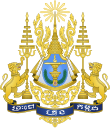Judiciary of Cambodia
Courts and tribunals in Cambodia regularly face a lack of resources, both financial and human, a ferment of corruption and clientelism that eat away at the whole of society.
The difficulty of access for the poorest also favors the resistance of traditional methods of conflict resolution, based on the intermediary of a person whose moral authority, unlike that of the judge, is not contested by neither of the two parties (village, district, pagoda chiefs, etc.
"[2] The first written traces of laws are Dharmashastra that appeared during the indianization of the Indochinese peninsula between the second and the thirteenth century, but these texts are above all codes of conduct respectful of secular customs and devoid of directive character.
[3] Moreover, when at the end of the nineteenth century French people such as Adhémard Leclère did research on the laws of the Angkorian period, they realize that they are for the most part unknown to magistrates.
At the highest level was now the Kram which derived from the sole monarch and had a general legislative scope; the Kret was also the work of the king, but covered the appointments, transfers and dismissals of senior officials.
Closely linked to politics, the National Committee for Justice officially came into force at the end of the single session of the Assembly of the Representatives of the People of Kampuchea (April 11–13, 1976) which, according to the article 9 of the Constitution, also had the task of appointing "magistrates at all levels (of the hierarchy)”.
Unlike the Soviet Union or the Socialist Republic of Việt Nam, Democratic Kampuchea stood out from other communist states on the planet by the absence of its judicial system.
The laws or Chbab emanated from the Council of State (under the Presidency of the Republic) and had to be approved by the National Assembly to be proclaimed or, if its application could not wait for the next parliamentary session, by decree-law.
Each minister or head of a public body could, at his level, enact an order or prakas, while the revolutionary committees can issued decisions or sachkdei samrach in compliance with any of the acts mentioned above.
But these implementations, by calling into question the previously established systems of influence, regularly lead to crises such as the quarrel between Ky Tech and Suon Visal, which disrupted the functioning of the bar for several years or the accusations of partiality of the Superior Council of the Judiciary after the transfer, in March 2004, of Judge Hing Thirith.
[13] The main duties of the judiciary are to prosecute criminals, settle lawsuits, and, most importantly, protect the freedoms and rights of Cambodian citizens.
[17] It is supposed to guarantee the independence of the judiciary and intervenes in matters relating to the promotions, transfers and remuneration of judges; it must also deal with complaints and decide, if necessary, on disciplinary sanctions against magistrates.
The Prakas are taken by a minister or the Governor of the central bank while the decision of sachkdei samrach is initiated by a member of the government (including the secretary of state) or the president of a public institution.
[18] In order to put an end to the confusion which then prevailed, the Superior Council of the Judiciary decided, on July 11, 2005, the administrative separation between the judges in charge of investigating cases and those conducting the trials.
Applicants to the profession must be of Cambodian nationality, have obtained a certificate of aptitude for the career of lawyer and a law degree or an equivalent diploma and not have been convicted of a criminal offense.
Finally, to ensure their independence, lawyers are required not to exercise a commercial activity or a job in the public service in Southeast Asia or in any political and jurisdictional Institutions in Cambodia.
